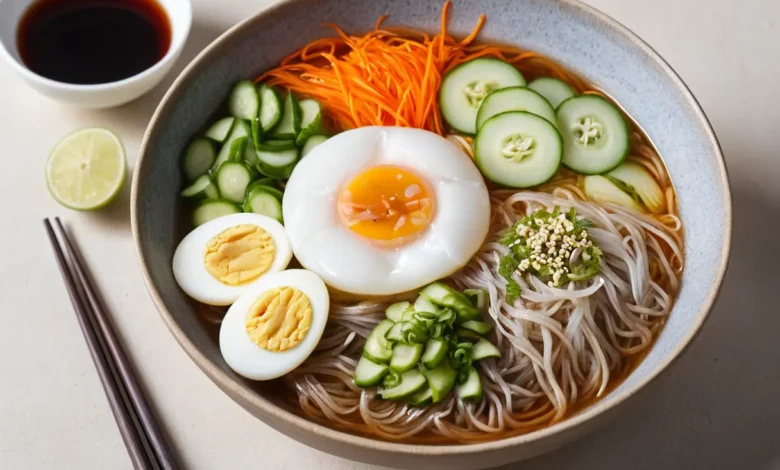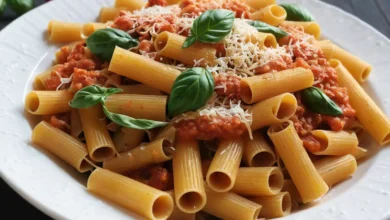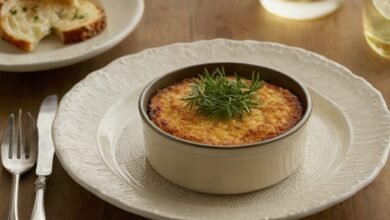Discover the Cool and Refreshing World of Naengmyeon: A Guide to Korea’s Favorite Summer Noodles

Naengmyeon, a beloved Korean dish known for its cool, refreshing taste and unique texture, has captivated food enthusiasts around the world. If you’ve never tried this delicious cold noodle dish, you’re in for a treat! Naengmyeon, often enjoyed in the summer to combat Korea’s hot and humid weather, is not only a tasty meal but also a cultural experience that embodies the rich flavors and culinary techniques of Korea.
But what makes naengmyeon so popular, and why do so many people seek it out during warm months? From its history to its health benefits, ingredients, and variations, let’s dive deep into the fascinating world of naengmyeon. Whether you’re a seasoned fan or a newcomer, this guide will answer all your questions and provide insights that make naengmyeon worth every bite.
What is Naengmyeon?
Naengmyeon, translating to “cold noodles” in Korean, is a dish made with long, thin noodles typically served in a chilled broth. The base of this dish often includes buckwheat noodles, which gives it a slightly chewy and earthy flavor. The dish is traditionally garnished with julienned vegetables, boiled eggs, and occasionally slices of meat, usually beef.
What makes naengmyeon particularly special is its refreshing broth. The broth, made from beef, dongchimi (radish water kimchi), or even a tangy vinegar-infused mixture, is chilled, making it an ideal way to cool down on a hot day.
Types of Naengmyeon
There are two popular types of naengmyeon: mul naengmyeon and bibim naengmyeon. Each offers a unique experience, catering to different tastes.
- Mul Naengmyeon: This is the classic cold noodle soup version, where noodles are served in an icy beef or dongchimi broth. It’s typically seasoned with vinegar and mustard for an extra tangy kick.
- Bibim Naengmyeon: Known as the spicier version, this dish is served without broth. Instead, the noodles are mixed with a spicy, red chili pepper paste sauce, offering a fiery contrast to its cool temperature.
Frequently Asked Questions About Naengmyeon
- Is naengmyeon healthy? Naengmyeon is relatively low in calories and fat, making it a healthy choice for those looking for a light yet satisfying meal. Buckwheat noodles are also high in fiber and contain essential amino acids, supporting heart health and digestion.
- Why is naengmyeon served cold? Historically, naengmyeon was enjoyed as a way to beat the heat, especially in Korea’s warm summers. The cold broth and chilled noodles offer instant relief from high temperatures.
- Can you eat naengmyeon in winter? Although popular in summer, many people in Korea enjoy naengmyeon year-round. The winter season adds a unique twist to its flavor, as it contrasts the cold noodles with the warmth of other winter dishes.
- What goes well with naengmyeon? Naengmyeon pairs well with Korean BBQ, as its refreshing taste balances the richness of grilled meats. Many people enjoy it as a palate cleanser after a hearty BBQ meal.
The Origin and Cultural Significance of Naengmyeon
Naengmyeon originated from North Korea, particularly from the Pyongyang and Hamhung regions. Each region has its own version—Pyongyang-style naengmyeon is known for its cold beef broth and buckwheat noodles, while Hamhung-style is recognized for its use of potato starch noodles and spicier flavors.
Naengmyeon has cultural importance as it was initially served in North Korea as a winter dish. In South Korea, it has evolved into a year-round staple and a culinary bridge to the northern Korean regions, preserving the traditions and flavors of Pyongyang and Hamhung.
Tips for Making Naengmyeon at Home
Making naengmyeon at home is simple with the right ingredients and a few preparation steps. Here are some essential tips for a successful dish:
- Choose the Right Noodles: Traditional naengmyeon noodles are made from buckwheat or potato starch. Make sure to cook them according to the package instructions, as they can become mushy if overcooked.
- Prepare a Flavorful Broth: For mul naengmyeon, beef or dongchimi broth works best. Cool the broth beforehand and add vinegar and mustard for a punch of flavor.
- Chill the Ingredients: Naengmyeon is best served cold, so ensure that the noodles, broth, and any garnishes are thoroughly chilled before assembling.
- Garnish Creatively: Add sliced cucumbers, pickled radish, or hard-boiled eggs to enhance the texture and taste. Thin slices of beef or pork are also a great addition.
Naengmyeon’s Health Benefits
With its low calorie and fat content, naengmyeon is an excellent choice for health-conscious eaters. Buckwheat noodles are rich in antioxidants, which are essential for protecting cells from damage, reducing inflammation, and supporting cardiovascular health. The fiber in buckwheat can aid digestion and help with weight management, making naengmyeon a balanced choice.
Studies have shown that buckwheat can improve blood sugar levels, which benefits those managing diabetes or pre-diabetic conditions. Additionally, naengmyeon’s broth often contains vital minerals and electrolytes, supporting hydration, especially during warm months.
Popular Variations of Naengmyeon
While mul naengmyeon and bibim naengmyeon are the most popular, several regional and modern variations have emerged, each offering a unique twist on the classic:
- Hwe Naengmyeon: This version incorporates raw fish, usually sashimi-style, for added flavor and protein.
- Dongchimi Naengmyeon: Made with radish water kimchi, this version offers a lighter, tangy broth ideal for warm weather.
- Spicy Pork Naengmyeon: A modern take, this variation includes spicy pork as a topping, combining smoky flavors with the refreshing cold noodles.
Best Places to Try Naengmyeon in Korea
If you’re visiting Korea, some famous restaurants are renowned for their naengmyeon. In Seoul, Eulmildae and Wooraeok are highly recommended for authentic Pyongyang-style naengmyeon. For a Hamhung-style experience, Heungnamjip in Seoul offers a spicy and chewy rendition.
Conclusion
Naengmyeon is more than just a meal—it’s an experience that encapsulates Korea’s culinary history, seasonal adaptability, and health-conscious approach to food. Its refreshing taste, diverse styles, and cultural significance make it a unique addition to the global culinary scene. Whether you’re dining out or experimenting at home, naengmyeon is a dish that invites you to savor Korea’s rich flavors and heritage in every bowl.
With its light, refreshing quality and a wide range of variations, naengmyeon is the perfect way to explore Korean cuisine and embrace a unique, delightful dining experience. Give naengmyeon a try, and discover why it has remained a beloved favorite for centuries.





